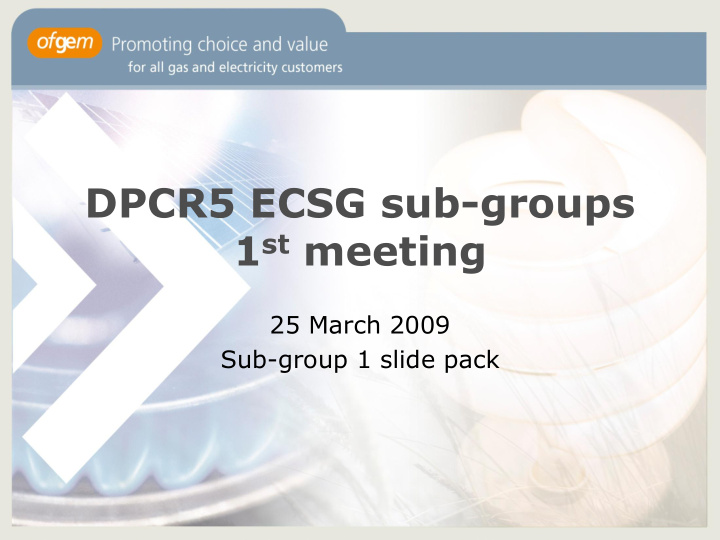



DPCR5 ECSG sub-groups 1 st meeting 25 March 2009 Sub-group 1 slide pack
Agenda • Setting the scene (45 mins) – TORs, modus operandi – Schedule of future meetings (handout) – Key DPCR5 project milestones • Breakout into subgroups (am – 1 hour 45 mins) – Recap on policy proposals – Summary of responses – Key discussion issues • Lunch (45 mins) • Discussion questions (pm - 1 hour 45 mins) – Subgroup 1 – market segmentation – Subgroup 2 – scope of standards & approach to standards setting • Feedback session – groups reconvene (30 mins) 2
Modus operandi • Expect participants to canvas views of colleagues • Strict adherence to agenda items • Cooperation between participants essential • No decisions or agreements required • Avoidance of discussions on levels of margins • Minute and summary to ECSG 3
Key project milestones and meeting schedule Working group meeting 1 25 March 2009 Working group meeting 2 Mid April 2009 Working group meeting 3 Early May 2009 Ofgem update consumer May 2009 challenge group Work group meeting 4 End May/Early June 2009 Publish initial proposals Late July 2009 Working group meeting 5 Mid September 2009 Working group meeting 6 Early October 2009 Working group meeting 7 Mid October 2009 Working group meeting 8 Late October 2009 Publish final proposals End November 2009 4
AM Breakout session: sub-group one
Recap on proposals: treatment of competitive connections for DPCR5 DPCR4 - No Margin allowed on competitive connections activities DPCR5 - Allow regulated margin on competitive connections activities for all DNOs By end December 2013 - DNOs must demonstrate meeting competition tests PASS FAIL Evidence of effective Little or no evidence Competition competition of competition developing but tests • DNO allowed to earn developing not yet met an unregulated margin, • Future margins • Ofgem extends contained by disallowed review period competition • Ofgem makes a • Continues to allow • Ofgem continues to referral to the regulated margin monitor competition Competition • Continues to monitor via CIR reporting Commission via CIR DNOs that meet tests from start of DPCR5 can set own margins 6
Recap on proposals: Potential scope of competition tests Market share Number/value of competitive connections • HHI scores • Market penetration Number of active ICPs/IDNOs (affiliates and non-affiliates) • Price Average price metric • Investigation findings Breaches of non-discrimination conditions of licence (SLC19) • Competition Act breaches • Customer awareness of Customer survey • competitive Number of competitive quotations issued • alternatives Facilitation of Enabling of LV live jointing • competition Quality of website information • Complaints ICP complaints to Ofgem/Ombudsman referrals • Other evidence of non-compliance with spirit of competition • Compliance with SLC15 90 per cent compliance specified • (Standards for the Services specified include proving quotations, responding to • provision of Non- requests for design approval and completion of works Contestable Connections Services) 7
Summary of responses • Would a regulated margin on connections facilitate competition? – Most DNOs supported the proposal – One DNO objected on the basis that prices would increase for rural customers who are unlikely to benefit from competition – Some ICPs accepted the principle but many expressed concerns with allowing any margin before DNOs meet the competition tests • At what level should a regulated margin be set? – Only one suggestion of 10% • How should the metrics be set? – DNOs wary of overweighting the influence of market share – One DNO thought that compliance with relevant licence conditions should not be a factor • Are the timescales for implementation appropriate? – A number of ICPs felt that timescales should be brought forward and suggested that competition tests to be taken by April 2010 – Some DNOs thought timescales where too conservative and should be extended (review in DPCR6) – One DNO agreed with the timescales proposed Refer to handout for summary of January workshop discussions 8
Key policy issues from responses • Potential price increases for rural customers – Rural connections unattractive to ICPs (regardless of voltage?) – Concern from some respondents that prices will increase without associated competition benefits • Principle of allowing margins before competition tests are met – Concerns about DNOs being rewarded upfront for a potentially inferior service – BUT some support for the principle of allowing headroom in pricing to attract competition • Weighting of market share test – Tests could be service oriented to accommodate DNOs retaining market share because they are competitive on price and service – External factors such as geography may also affect attractiveness of certain segments 9
PM Breakout session: Market segmentation
December document view on market segmentation Market segment Market value Competitive potential LV small scale £353 million Unlikely - low value, low domestic (1-4 margin work premises) Remaining LV market High potential HV £53 million High potential EHV £45 million Low volumes, highly specialist, scope for growth DG £36 million Low volumes, scope for growth Unmetered £45 million Initial low uptake but connections growing [1] Based on charges levied by DNOs and IDNOs. Totals do not include the value of connections undertaken by independent connection providers. [2] Total value of LV market. 11
Discussion questions • Potential approaches to market segmentation by: – Voltage – Number of premises – Rural/urban – Contestable/non-contestable activity – Domestic/non-domestic – Greenfield/brownfield – Any other factors? • Competition potential in identified segments (taking account of size and value) • Identification of segments where competition is unlikely to develop or which are non-contestable 12
13
Recommend
More recommend